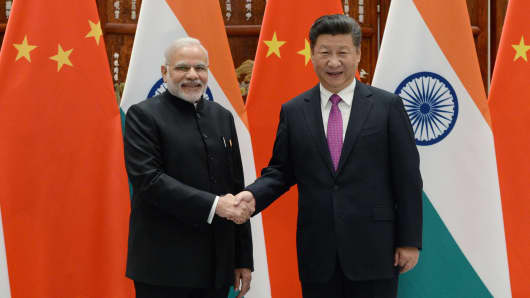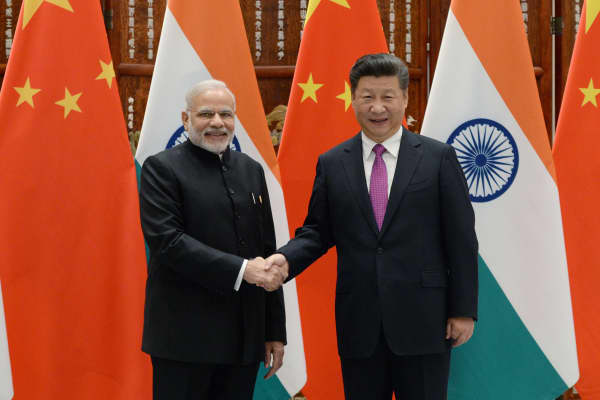Dr. Michael Ivanovitch
 The Sino-Indian summit last week could be a new departure for neighbors who realize there is no alternative to constructive political, economic and security engagement. China and India are part of a Eurasian institution that can make that possible. Those two countries could soon become the key drivers of global demand and output. Trust is an economic variable sounded like an echo swirling around Wuhan's East Lake in China as President Xi Jinping was hosting last Friday and Saturday Indian Prime Minister Narendra Modi for an "informal," "heart-to-heart" summit.
The Sino-Indian summit last week could be a new departure for neighbors who realize there is no alternative to constructive political, economic and security engagement. China and India are part of a Eurasian institution that can make that possible. Those two countries could soon become the key drivers of global demand and output. Trust is an economic variable sounded like an echo swirling around Wuhan's East Lake in China as President Xi Jinping was hosting last Friday and Saturday Indian Prime Minister Narendra Modi for an "informal," "heart-to-heart" summit.
References to the two countries' cultures and civilizations, and metaphors about the sacred Yangtze and Ganges rivers, were abundantly used to underscore the importance of trust and mutual understanding for the strategic partnership of Asian neighbors who account for 35 percent of humanity and a quarter of the world economy.
That exalted talk may have been the proper mood music for the occasion, but an economic technician could have thought how simple and easy it would be for the two countries to solve one of their key bilateral issues. For example, India's relatively small $40 billion savings-investment gap could be easily closed by China's $165 billion of excess savings looking for foreign portfolio and direct investments.
Simple? Not quite. Investments are an act of faith and a leap into unknown where trust acts as a sort of ultima ratio in risk-adjusted profit assessments.
Opt for a 'win-win' deal
And risks are plentiful along an unresolved Sino-Indian land border that stretches more than 2,000 miles. There is also a China-financed $50 billion Pakistani economic corridor passing through the contested part of Kashmir. Beijing is viewed with suspicion for its intrusions into India's traditional spheres of influence (Sri Lanka, Bangladesh, Nepal and the Maldives), while China apparently believes India is a geopolitical swing state.
Those were some of the key topics Xi and Modi discussed last week in an attempt to establish a stable and predictable bilateral relationship that would support a world order based on globalization, multilateralism and peaceful coexistence.
That was all very similar to what Chinese Paramount Leader Deng Xiaoping and Indian Prime Minister Rajiv Gandhi talked about 30 years ago as they sought to mend ties following a short border war China and India fought in 1962. It was on that chilly morning in December 1988 that Deng, in a long handshake, greeted his guest "I welcome you to China, my young friend," and a prophecy that "the Century of Asia will not come without the development of China and India."
At that time, the two economies were relatively close in terms of economic output. China's economy now is five times bigger, and China's defense budget is three times larger than India's.
India, therefore, has a lot of catching up to do, even if it could manage to maintain for some time the current 7.2 percent growth rate.
That might be a big challenge, though. India's fiscal policy looks a bit stretched with a consolidated public sector budget deficit of about 6 percent of GDP, and the gross public debt of 69 percent of GDP. The same is true of the monetary policy, where the real short-term interest rate of 1.7 percent is too low for this phase of the business cycle.
Such an expansionary policy mix is likely to pose problems at a time when the consumer and wholesale prices are projected to accelerate considerably in the months ahead.
China should recycle trade surplus to India
The strong consumer-led domestic demand will also widen India's trade gap — one of the key issues discussed with China during the Wuhan summit.
On current evidence, that's happening already. In the course of the first quarter of this year, India's merchandise trade deficit shot up 8 percent. During all of last year, the deficit on goods and services trade (the current account) more than tripled.
China, India's largest trade partner, can definitely help with all that by buying more from India to cut down last year's trade surplus of $51.7 billion, which was an increase of 8.5 percent from 2016.
China is doing some of that. India's exports to China last year increased 39.1 percent to $16.3 billion. But there is still a long way to go because China takes only about 4 percent of India's exports, while, incredibly, the European Union remains Delhi's main export market, absorbing nearly 20 percent of Indian sales abroad.
Diamonds, copper, iron ore, organic chemicals and cotton yarn have been among India's bestsellers to China. Delhi could also try to sell software and other IT products. Tourism is another potentially hot-selling product of India's vast hospitality industry. At the moment, India says it is getting only 1 percent of some 150 million Chinese traveling overseas.
India may also wish to join China's Belt and Road infrastructure projects.
And then there are those 35,000 kilometers of highways and rail lines India wants to build over the next five years. Some India analysts are apparently wondering how to finance all that at an estimated cost equivalent to 3.4 percent of GDP.
That should be easy because the cost is just a little more than what China takes as a one-year trade surplus with India. So, China can recycle that money back to India to build modern infrastructure that would set the foundation for India's sustainable, faster and balanced growth.
Indeed, China trade should not be a drag on India's economic growth. It should be a golden opportunity to solve India's key problems of social welfare and a means of stopping, and reversing, the growth of the country's net international liabilities amounting to $430 billion at the end of 2017.
A broader question is that $84.4 billion in Sino-Indian bilateral trade last year is much too low. That number does not reflect the potential of an economic engagement of countries with a combined population of about 2.7 billion.
Investment thoughts
There have been many false starts to establish stronger and more confident ties between China and India. The summit last week seems to have been different because the international context and the bilateral conditions were conducive to a strategic rapprochement of leaders who realize that there are no alternatives to cooperation.
China and India are now also bound by closer relations within the Shanghai Cooperation Organization (SCO) — a political, economic and security institution whose membership includes Russia, Pakistan and a number of smaller post-Soviet Central Asian countries. The Xi-Modi meeting last week can be considered as a preparation for the June SCO summit in the Chinese city of Qingdao.
Trust and mutual understanding among nation states are fragile and elusive concepts. It seems, however, that Beijing and Delhi have decided to try that — after they explored other options. I am, therefore, inclined to believe that the stage is set for a new Sino-Indian chapter of the world economy.
Commentary by Michael Ivanovitch, an independent analyst focusing on world economy, geopolitics and investment strategy. He served as a senior economist at the OECD in Paris, international economist at the Federal Reserve Bank of New York, and taught economics at Columbia Business School.

No comments:
Post a Comment